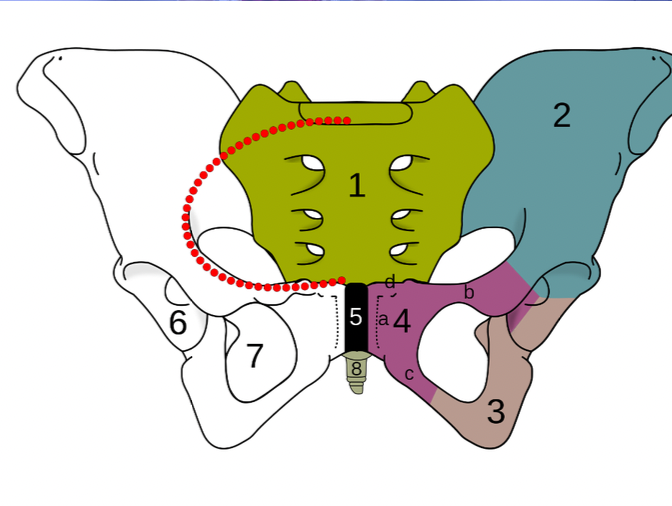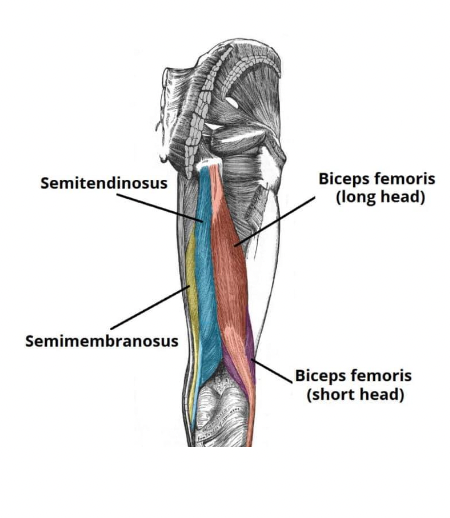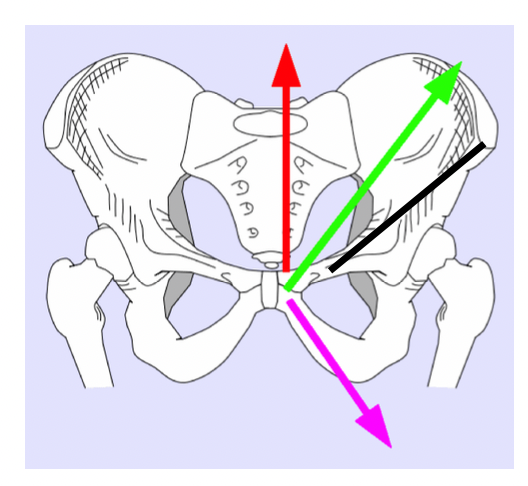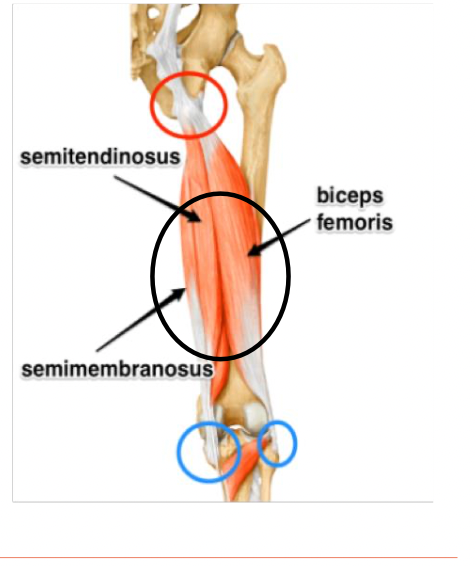Athletic Training: Hip & Thigh injuries
1/9
There's no tags or description
Looks like no tags are added yet.
Name | Mastery | Learn | Test | Matching | Spaced |
|---|
No study sessions yet.
10 Terms

Explain some key anatomical features of the pelvic girdle by labeling the following image
Sacrum - continuation of spine
Ilium: (1 + 2 = sacro-iliac joint); Anterior superior Iliac spine (see arrow)
Ischium (2-4 make up the hip (pelvic girdle))
Pubis
Pubic Symphysis: btwn pubic bones
Acetabulum: articulation w femoral head

What are the 3 muscles of the hamstrings
Biceps femoris; short and long heads (lateral)
Semitendinosus (medial)
Semimembranosus (medial)

Explain this injury: Iliac Crest Contusion
AKA "hip pointer"
MOI: Direct blow to bony iliac crest
Bone or muscle (oblique's)
S/S: Hematoma formation w ecchymosis, extremely painful & debilitating
Explain this injury: Piriformis Syndrome
spasm or tightening of piriformis muscle
pressure on sciatic nerve
Entrapment neuropathy
S/S: point tender, sciatica
Treatment: rest and stretching
Explain this injury: Femoro-acetabular Impingement (FAI) and Labral tears
Bony abnormalities
CAM: head/neck of femur
Pincer: acetabulum
Mixed: both
Pain Patterns
FABER: flexion, abduction, and ER
FADIR: flexion, adduction, and IR
Causes: inflexibility and hypomobility or hypermobility
Labral tears: catching or clunking sensation

Explain this injury: Athletic Pubalgia "sports hernia”
MOI: Twisting w foot planted: sudden change of directions
S/S: nagging deep groin pain, pain w hip flexion, valsalva
Imaging: MRI, Treatment: conservative or surgical
Hard to determine source of problem
Oblique's (green)
Rectus abdominus (red)
Inguinal ligament and canal (black)
Adductor muscles (violet)

Explain this Injury: Osteitis Pubis
Pubic symphysis (immovable joint): fibrocartilage
MOI: Repetitive stress (compression and shear), common in distance runners
S/S: chronic deep groin pain, point tender over joint, pain w weight-bearing movements
Explain this injury; Hip flexor strain
Rectus femoris: upper third (tendon region)
MOI: eccentric loading
Management: stretching, strengthen (low load, high rep), wrapping
Explain this Injury: Hamstring Strain
Origin: Ischial tuberosity (red); Insettion on tibia/fibula (blue circles)
Smaller than quads, can't handle as much load
Prevalence:
2/3rd biceps femoris (shortest group, most angulated
1/3rd semitendinosus
Intramuscular tendon/CT issues
Very high recurrence rate: acute on chronic
MOI: sprinting, hip flexed while knee extended, eccentric loading
S/S: thigh swollen and discolored (ecchymosis), fiber disruption, hematoma w edema
Middle of the hamstring usually acute; Distal and proximal often overuse tendon injury from from running or cycling
Management: PRICE, restore strength and flexibility, neoprene sleve or ACE bandage

Explain this injury: Quadriceps Contusion
Direct blow to muscle (external force); penetrates deeper when muscle relaxed
Bleeding w resultant loacalixed hematoma
Classified as mild, moderate, or severe
S/S: Limited ROM, stiff and firm on palpation, extremely tender, and sore, difficulties in ambulation (walking)
Can cause myocitis ossificans
Management:
Acute: PRICE, Ice w stretch,
Post acute: heat once inflammation is neutralized, stretching
Long term care: protection, prevent repeated trauma, padding with hard shell covering